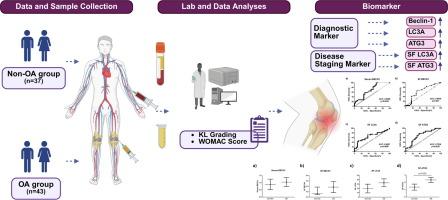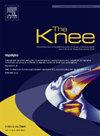Association of autophagy-related proteins in serum and synovial fluid with the severity of knee osteoarthritis
IF 2
4区 医学
Q3 ORTHOPEDICS
引用次数: 0
Abstract
Background
Osteoarthritis (OA) is a highly prevalent painful joint disease that significantly reduces the quality of life and causes physical disability. Recently, autophagy has gained significant attention due to its role in the pathogenesis of OA. However, there is no study examining the role of autophagy-related proteins (ATGs) in the serum and synovial fluid (SF) of OA patients. Here, we aim to investigate the relationship of ATGs with the radiographic findings and symptomatic severity of knee OA.
Methods
We enrolled 43 OA patients and 37 patients with other knee joint disorders (non-OA knee disease) in the study. The radiographic grading and symptomatic severity of OA were evaluated using the Western Ontario McMaster University Osteoarthritis Index (WOMAC) scores and the Kellgren-Lawrence (KL) classification, respectively. ATGs, including BECN1, LC3A and ATG3 were measured with an enzyme-linked immunosorbent assay.
Results
BECN1 expressions in the OA group were higher than in the non-OA knee disease group (p < 0.05). The SF LC3A and SF ATG3 expressions in OA were markedly elevated compared to the non-OA knee disease group (p < 0.05). SF LC3A and SF ATG3 expressions in grade 4 OA patients were higher than in grade 3 OA patients (p < 0.05). Moreover, SF ATG3 was significantly correlated with the severity of OA symptoms. We found that the area under the ROC curve for serum BECN1, SF BECN1, SF LC3A, and SF ATG3 was 0.6908, 0.6496, 0.6681, and 0.7034, respectively (p < 0.05).
Conclusion
We report that ATGs might indicate potential diagnostic value and are closely associated with the severity and progression of OA.

血清和滑液中自噬相关蛋白与膝关节骨关节炎严重程度的关系
骨关节炎(OA)是一种非常普遍的关节疼痛疾病,它会显著降低生活质量并导致身体残疾。近年来,自噬在OA发病机制中的作用引起了人们的广泛关注。然而,目前还没有研究检测自噬相关蛋白(ATGs)在OA患者血清和滑液(SF)中的作用。在这里,我们的目的是研究ATGs与膝关节OA的影像学表现和症状严重程度的关系。方法纳入43例OA患者和37例其他膝关节疾病(非OA膝关节疾病)患者。分别采用西安大略麦克马斯特大学骨关节炎指数(WOMAC)评分和Kellgren-Lawrence (KL)分级对骨性关节炎的影像学分级和症状严重程度进行评估。采用酶联免疫吸附法测定ATGs,包括BECN1、LC3A和ATG3。结果骨性关节炎组becn1表达高于非骨性关节炎组(p <;0.05)。与非OA组相比,OA组SF LC3A和SF ATG3表达明显升高(p <;0.05)。4级OA患者SF LC3A和SF ATG3表达高于3级OA患者(p <;0.05)。此外,SF ATG3与OA症状的严重程度显著相关。我们发现血清BECN1、SF BECN1、SF LC3A和SF ATG3的ROC曲线下面积分别为0.6908、0.6496、0.6681和0.7034 (p <;0.05)。结论ATGs可能具有潜在的诊断价值,并与OA的严重程度和进展密切相关。
本文章由计算机程序翻译,如有差异,请以英文原文为准。
求助全文
约1分钟内获得全文
求助全文
来源期刊

Knee
医学-外科
CiteScore
3.80
自引率
5.30%
发文量
171
审稿时长
6 months
期刊介绍:
The Knee is an international journal publishing studies on the clinical treatment and fundamental biomechanical characteristics of this joint. The aim of the journal is to provide a vehicle relevant to surgeons, biomedical engineers, imaging specialists, materials scientists, rehabilitation personnel and all those with an interest in the knee.
The topics covered include, but are not limited to:
• Anatomy, physiology, morphology and biochemistry;
• Biomechanical studies;
• Advances in the development of prosthetic, orthotic and augmentation devices;
• Imaging and diagnostic techniques;
• Pathology;
• Trauma;
• Surgery;
• Rehabilitation.
 求助内容:
求助内容: 应助结果提醒方式:
应助结果提醒方式:


